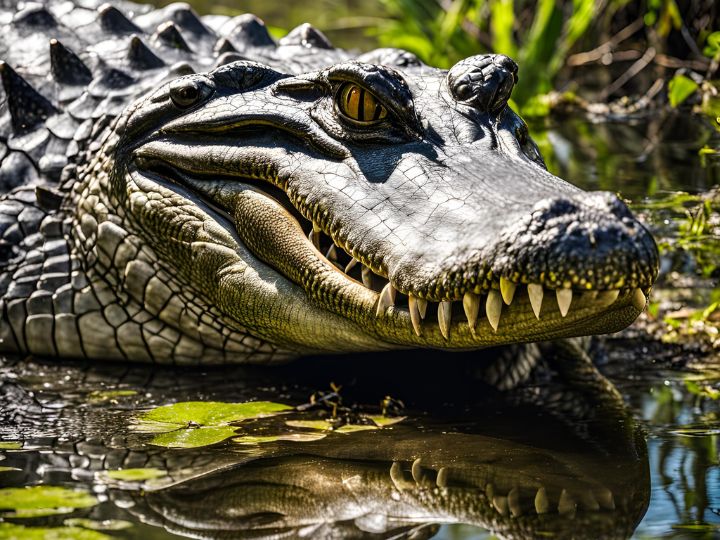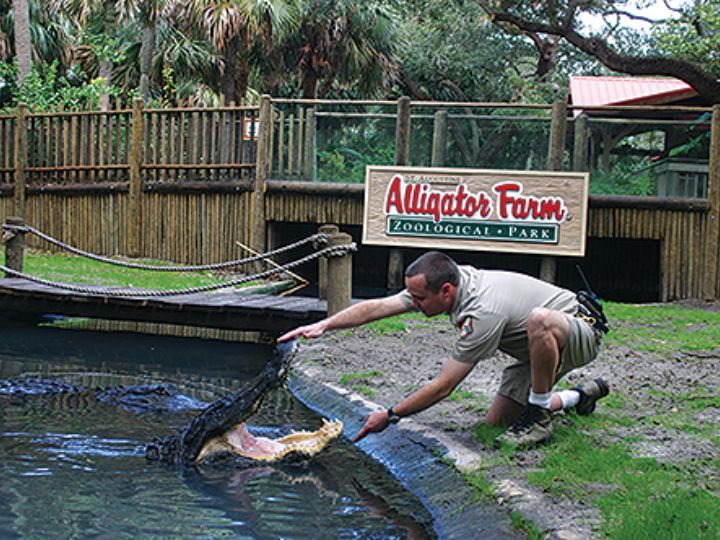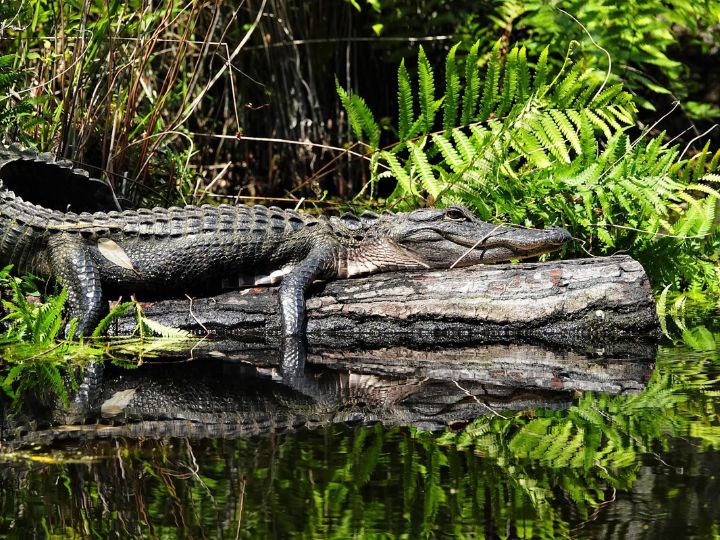Florida, famously known as the “Sunshine State,” is also home to an impressive population of American alligators. These iconic reptiles thrive in Florida’s subtropical climate and can be found in the state’s freshwater rivers, lakes, swamps, and marshes.
Whether you’re a nature enthusiast, a photographer, or just curious about these ancient creatures, Florida offers numerous spots where you can safely view alligators in their natural habitat.
Here’s a guide to the top places to see alligators in Florida.
Where Can You See Alligators in Florida

In central Florida, there are plenty of places where you can see alligators in their natural habitat. The Everglades Alligator Farm is one of the best places to see an alligator, where you’re guaranteed to see these fascinating creatures, including baby alligators. You can also ride an airboat through Alligator Alley to spot wild alligators along the waterways.
For a unique experience, visit Everglades Holiday Park or explore wildlife refuges and wetlands parks in south Florida. The Florida Keys also offer opportunities to see alligators in central Florida, while southwest Florida has some of the best places to feed the alligators. Whether in southern Florida or Wakulla, it’s a great place to experience Florida’s alligators up close.
1. Everglades National Park

The Everglades is perhaps the most iconic location in Florida to see alligators. Spanning over 1.5 million acres, this UNESCO World Heritage Site is a vast network of wetlands and forests teeming with wildlife.
Coordinates: 25°18′45″N 80°41′15″W / 25.3125000°N 80.6875000°W
- Where to Look: The Shark Valley Visitor Center is a great starting point. It offers a 15-mile paved trail on which alligators are frequently spotted sunning along the banks.
- Unique Experience: Guided airboat tours and tram rides allow visitors to get a closer look at the alligators while educating them about their role in the ecosystem.
- Safety Tip: Always maintain a safe distance from alligators, as they are wild animals and can quickly move.
2. Gatorland

If you’re looking for a controlled environment to see alligators up close, Gatorland in Orlando is a must-visit. Dubbed the “Alligator Capital of the World,” this wildlife park is home to thousands of alligators and crocodiles.
Address: 14501 S Orange Blossom Trl, Orlando, FL 32837
- What to Do: Watch live feeding shows, take a zipline ride over alligator-infested waters, or visit the breeding marsh for a behind-the-scenes look at these reptiles.
- Family-Friendly Fun: Gatorland is an excellent choice for families with children, as it combines education and entertainment in a safe setting.
3. Myakka River State Park

Located near Sarasota, Myakka River State Park is one of Florida’s oldest and largest parks. It features a blend of rivers, wetlands, and prairies.
Coordinates: 27°14′22″N 82°19′00″W / 27.23944°N 82.31667°W
- Alligator Hotspots: The Myakka River and Upper Myakka Lake are prime locations for spotting alligators basking in the sun.
- Outdoor Activities: Visitors can enjoy hiking, kayaking, and scenic airboat tours that offer excellent vantage points for observing alligators.
- Seasonal Tip: The dry season (November to May) is ideal for wildlife spotting, as water levels are lower and alligators are more concentrated around remaining water sources.
4. Lake Okeechobee

Lake Okeechobee, the largest freshwater lake in Florida, is a haven for alligators and other wildlife. Its vast shoreline and surrounding marshes provide ample opportunities for wildlife enthusiasts.
- Best Viewing Points: Public access points and hiking trails along the Herbert Hoover Dike offer safe spots to see alligators.
- Fishing Adventures: Anglers often encounter alligators while fishing, making it a standard yet thrilling part of the experience.
5. St. Augustine Alligator Farm Zoological Park

For a more educational and close-up experience, the St. Augustine Alligator Farm is a great destination. It’s the only place in the world with every crocodilian species on display, including rare alligator species.
Address: 999 Anastasia Blvd, St. Augustine, FL 32080
- Attractions: The park features daily feedings, wildlife shows, and a thrilling zipline adventure that lets you soar above the alligators.
- Educational Value: Learn about alligator conservation efforts and the differences between alligators and crocodiles.
6. Blackwater Wildlife Management Area

Located in the Florida Panhandle, the Blackwater Wildlife Management Area is a lesser-known yet excellent spot for viewing alligators.
Address: 11650 Munson Hwy, Milton, FL 32570
- Natural Setting: This area features a mix of swamps, creeks, and pine forests that create a serene environment for wildlife viewing.
- Photography Opportunity: This area’s secluded nature makes it perfect for photographers looking to capture alligators in a tranquil setting.
Alligators and Crocodiles – the Differences
Although alligators and crocodiles belong to the same reptilian order, Crocodylia, they are distinct species with key differences in appearance, behavior, and habitat.
Here’s a quick guide to help you tell them apart:
1. Snout Shape
- Alligators: Have a broad, U-shaped snout, which is well-suited for crushing prey like turtles and other hard-shelled animals.
- Crocodiles: Feature a narrower, V-shaped snout, which allows for a stronger bite and better adaptation to hunting fish and other aquatic prey.
2. Teeth Visibility
- Alligators: Only the upper teeth are visible when their mouths are closed because the lower jaw fits snugly inside the upper jaw.
- Crocodiles: Show upper and lower teeth when their mouths are closed, giving them a more jagged, toothy appearance.
3. Skin Color
- Alligators: Typically have darker, almost black skin, which helps them blend into murky freshwater environments.
- Crocodiles Tend to have lighter, olive, or tan-colored skin, which matches their coastal and brackish water habitats.
4. Habitat
- Alligators: Prefer freshwater environments such as rivers, lakes, and swamps. They are primarily found in the southeastern United States and parts of China.
- Crocodiles are more versatile and can live in fresh and saltwater environments. In Florida, American crocodiles are primarily found in coastal areas near the state’s southern tip.
5. Behavior
- Alligators: Are generally less aggressive toward humans and tend to avoid confrontation unless provoked or defending their territory.
- Crocodiles: These are known to be more aggressive and territorial, and significantly larger species, such as the Nile and saltwater crocodiles, are found outside the U.S.
6. Size
- Alligators: Typically grow up to 13-14 feet in length, with males being larger than females.
- Crocodiles: Can grow larger than alligators, with some species, like the saltwater crocodile, reaching lengths of over 20 feet.
Florida’s Unique Connection
You can find alligators and crocodiles in Florida, making it one of the few places where their habitats overlap. However, spotting an American crocodile is much rarer than encountering an alligator, as crocodiles are primarily confined to coastal and brackish waters near the Everglades.
Understanding these differences adds a fascinating layer to your wildlife experience in Florida, helping you appreciate the diversity of its reptilian residents.
General Tips for Viewing Alligators
- Stay Safe: Always observe alligators from a distance. Avoid feeding them, as it is illegal and can make them more aggressive.
- Best Time to Visit: Alligators are most active during warm months but can be seen year-round. Early mornings and late afternoons are ideal times for sightings.
- Bring Binoculars: A good pair of binoculars can enhance your experience, especially in more expansive habitats like the Everglades or Lake Okeechobee.
Final Thoughts
From the wild marshes of the Everglades to educational hubs like Gatorland, Florida offers a wealth of opportunities to observe these fascinating creatures. Whether you prefer an adventurous trek through nature or a family-friendly outing, there’s a spot perfect for your next alligator-viewing adventure. Don’t forget your camera and a sense of wonder as you explore the habitats of Florida’s most famous reptile!
